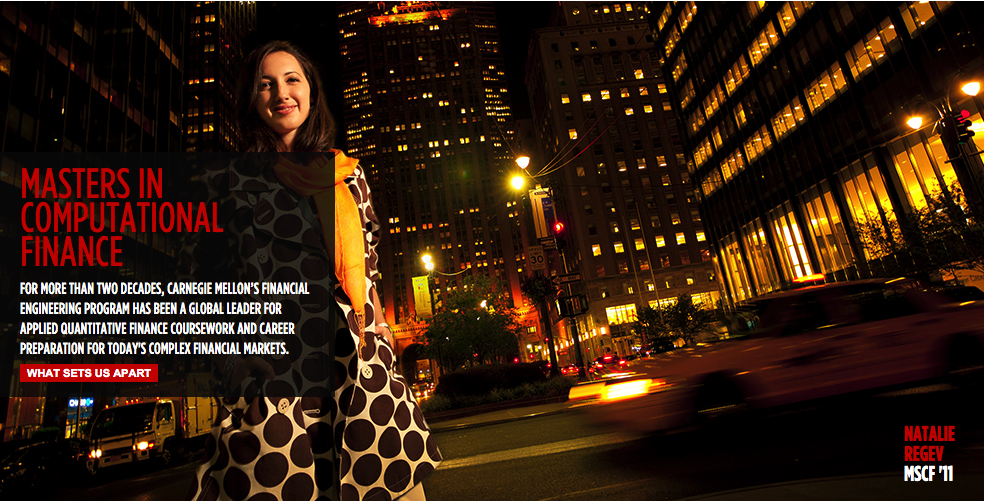CMU’s MSCF Program
Carnegie Mellon’s Steve Shreve is out with an interesting post on careers in quantitative finance, with his commentary on the changing landscape in quantitative research and the implications for financial education.
I taught at Carnegie Mellon in the late 1990’s, including its excellent Master’s program in quantitative finance that Steve co-founded, with Sanjay Srivastava. The program was revolutionary in many ways and was immediately successful and rapidly copied by rival graduate schools (I help to spread the word a little, at Cambridge).
 The core of the program remains largely unchanged over the last 20 years, featuring Steve’s excellent foundation course in stochastic calculus; but I am happy to see that the school has added many, new and highly relevant topics to the second year syllabus, including market microstructure, machine learning, algorithmic trading and statistical arbitrage. This has moved the program in terms of its primary focus, which was originally financial engineering, to include coverage of subjects that are highly relevant to quantitative investment research and trading.
The core of the program remains largely unchanged over the last 20 years, featuring Steve’s excellent foundation course in stochastic calculus; but I am happy to see that the school has added many, new and highly relevant topics to the second year syllabus, including market microstructure, machine learning, algorithmic trading and statistical arbitrage. This has moved the program in terms of its primary focus, which was originally financial engineering, to include coverage of subjects that are highly relevant to quantitative investment research and trading.
It was this combination of sound theoretical grounding with practitioner-oriented training that made the program so successful. As I recall, every single graduate was successful in finding a job on Wall Street, often at salaries in excess of $200,000, a considerable sum in those days. One of the key features of the program was that it combined theoretical concepts with practical training, using a simulated trading floor gifted by Thomson Reuters (a model later adopted b y the ICMA centre at the University of Reading in the UK). This enabled us to test students’ understanding of what they had been taught, using market simulation models that relied upon key theoretical ideas covered in the program. The constant reinforcement of the theoretical with the practical made for a much deeper learning experience for most students and greatly facilitated their transition to Wall Street.
y the ICMA centre at the University of Reading in the UK). This enabled us to test students’ understanding of what they had been taught, using market simulation models that relied upon key theoretical ideas covered in the program. The constant reinforcement of the theoretical with the practical made for a much deeper learning experience for most students and greatly facilitated their transition to Wall Street.
Masters in High Frequency Finance
While CMU’s program has certainly evolved and remains highly relevant to the recruitment needs of Wall Street firms, I still believe there is an opportunity for a program focused exclusively on high frequency finance, as previously described in this post. The MHFF program would be more computer science oriented, with less emphasis placed on financial engineering topics. So, for instance, students would learn about trading hardware and infrastructure, the principles of efficient algorithm design, as well as HFT trading techniques such as order layering and priority management. The program would also cover HFT strategies such as latency arbitrage, market making, and statistical arbitrage. Students would learn both lower level (C++, Java) and higher level (Matlab, R) programming languages and there is a good case for a mandatory machine code programming course also. Other core courses might include stochastic calculus and market microstructure.
Who would run such a program? The ideal school would have a reputation for excellent in both finance and computer science. CMU is an obvious candidate, as is MIT, but there are many other excellent possibilities.
Careers
I’ve been involved in quantitative finance since the beginning: I recall programming one of the first 68000 Assembler microcomputers in the 1980s, which was ultimately used for an F/X system at a major UK bank. The ensuing rapid proliferation of quantitative techniques in finance has been fueled by the ubiquity of cheap computing power, facilitating the deployment of quantitate techniques that would previously been impractical to implement due to their complexity. A good example is the machine learning techniques that now pervade large swathes of the finance arena, from credit scoring to HFT trading. When I first began working in that field in the early 2000’s it was necessary to assemble a fairly sizable cluster of cpus to handle the computation load. These days you can access comparable levels of computational power on a single server and, if you need more, you can easily scale up via Azure or EC2.
 It is this explosive growth in computing power that has driven the development of quantitative finance in both the financial engineering and quantitative investment disciplines. As the same time, the huge reduction in the cost of computing power has leveled the playing field and lowered barriers to entry. What was once the exclusive preserve of the sell-side has now become readily available to many buy-side firms. As a consequence, much of the growth in employment opportunities in quantitative finance over the last 20 years has been on the buy-side, with the arrival of quantitative hedge funds and proprietary trading firms, including my own, Systematic Strategies. This trend has a long way to play out so that, when also taking into consideration the increasing restrictions that sell-side firms face in terms of their proprietary trading activity, I am inclined to believe that the buy-side will offer the best employment opportunities for quantitative financiers over the next decade.
It is this explosive growth in computing power that has driven the development of quantitative finance in both the financial engineering and quantitative investment disciplines. As the same time, the huge reduction in the cost of computing power has leveled the playing field and lowered barriers to entry. What was once the exclusive preserve of the sell-side has now become readily available to many buy-side firms. As a consequence, much of the growth in employment opportunities in quantitative finance over the last 20 years has been on the buy-side, with the arrival of quantitative hedge funds and proprietary trading firms, including my own, Systematic Strategies. This trend has a long way to play out so that, when also taking into consideration the increasing restrictions that sell-side firms face in terms of their proprietary trading activity, I am inclined to believe that the buy-side will offer the best employment opportunities for quantitative financiers over the next decade.
It was often said that hedge fund managers are typically in their 30’s or 40’s when they make the move to the buy-side. That has changed in the last 15 years, again driven by the developments in technology. These days you are more likely to find the critically important technical skills in younger candidates, in their late 20’s or early 30’s. My advice to those looking for a career in quantitative finance, who are unable to find the right job opportunity, would be: do what every other young person in Silicon Valley is doing: join a startup, or start one yourself.




